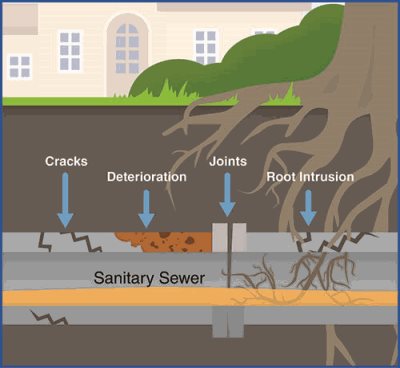A $500,000 grant to Saint Paul from the Metropolitan Council aims to show the effectiveness of working with private property owners to reduce inflow and infiltration (I/I) of stormwater and groundwater (clear water) into the regional wastewater collection system.
 Cities and the Metropolitan Council have been working for more than a decade, spending more than $175 million, to reduce I/I in aging public infrastructure. That’s because I/I consumes valuable space in wastewater pipes; it can also create sewage back-ups into homes and overflows into lakes and creeks.
Cities and the Metropolitan Council have been working for more than a decade, spending more than $175 million, to reduce I/I in aging public infrastructure. That’s because I/I consumes valuable space in wastewater pipes; it can also create sewage back-ups into homes and overflows into lakes and creeks.
Up to 80% of excess I/I comes from private property sources. Addressing those sources is critical to protecting public health and ensuring the regional wastewater system has enough capacity to handle projected population growth in the coming years.
“The alternative to solving the problem at the source is building even bigger sewer pipes and expanding our treatment plants,” explained Jeannine Clancy, assistant general manager for the Council’s Environmental Services division. “This would cost billions of dollars and cause unnecessary disruption to communities and transportation systems. Addressing I/I on private property is the most cost-effective solution.
“Unchecked, excessive I/I could begin to restrict redevelopment potential in some cities,” Clancy said.
The Council’s 2016 I/I Task Force, which included representatives from a broad range of cities connected to the regional wastewater collection system, recommended a local demonstration project be funded. The Council funded the grant through its general property tax levy. Saint Paul’s three-year demonstration proposal came out on top in a competitive grant process in 2018.
Repairing damaged service lines from buildings to the street
.aspx?width=400&height=266) Clear water gets into the wastewater system in several ways: through cracked sewer pipes and leaky pipe joints (infiltration), or through rain leaders, basement sump pumps, or foundation drains illegally connected to a sanitary sewer pipe (inflow).
Clear water gets into the wastewater system in several ways: through cracked sewer pipes and leaky pipe joints (infiltration), or through rain leaders, basement sump pumps, or foundation drains illegally connected to a sanitary sewer pipe (inflow).
The Saint Paul project focuses on private pipes, called service laterals, that convey wastewater from homes and businesses to the city wastewater pipe in the street. The city chose West Side Flats, across the Mississippi River from downtown Saint Paul, as the target area for the grant.
“The results of our collaboration will be valuable to other cities and townships in the region that are working to reduce I/I,” Clancy said.
Targeted area means better data on results of repairs
To date in 2019, the city has:
-
Developed the strategy to complete the project.
-
Reached out to property owners in West Side Flats about the benefits of the project.
-
Installed flow meters throughout the project area.
-
Begun inspecting sewer service pipes.
Part of the grant funding will pay to repair faulty service pipes.
Some communities, including Golden Valley and West St. Paul, have reduced I/I from private property sources using a point-of-sale program. This program requires inspection and repair of defective private service lines when a house is sold.
The Saint Paul demonstration will be one of the first to accurately quantify the reduction created by specific repairs because of the targeted area of the project.
Climate change bringing more rain to region, adding to I/I problem
On average, annual rainfall in the Twin Cities has increased from 26 inches in the 1940s-1970s to 31 inches in the 1980s-2000s, and has further grown in the last decade, according to Kenny Blumenfeld, climatologist with the Minnesota Department of Natural Resources. That’s the result of climate change, said Blumenfeld, who predicts the trend will continue.

Frequency of rainfall events and increased rainfall intensity contribute to the I/I problem and the urgency of solving it, Clancy said.
The Met Council is also funding — through its Environmental Services capital program — a study of the impact of rainfall events on wastewater flow in the regional wastewater collection system in Minneapolis.